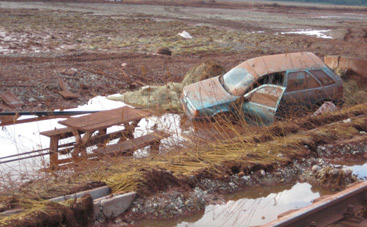Danube Watch 2/2016 - Tailing ponds: still a risk in the Danube basin?
Tailing ponds: still a risk in the Danube basin?
Tragic environmental accidents around the world serve as a call for more caution with tailing ponds and mining sites, and the need for greater preparation for the unforeseeable – at the local, national and international level.

A wave of caustic red mud from a burst tailing pond at a bauxite mine in Hungary devastated the villages of Kolontár and Devecser, where the flow was powerful enough to move cars. The disaster, which occurred in 2010, is the most recent accident in the Danube Basin.
© General Directorate of Water Management of Hungary
A few months ago, on 5 November 2015, the huge tailing pond of an iron mining company collapsed in Bento Rodrigues, Brazil, contaminating the Doce River with 62 million cubic metres of poisonous sludge for 600 km to the mouth at the Atlantic Ocean. The accident destroyed 158 homes, devastated 15 km², disrupted drinking water supplies, and killed at least 17 people.
A tailing pond is the wet storage area for the waste and by-products left over from mining – such as sludge or liquid chemical waste of mining plants. Such tailing ponds are often very large. The long list of tailing dam failures shows that tailing ponds are hazardous and offers a chilling reminder of Murphy’s Law: whatever can go wrong will go wrong.
Accidents in the Danube River Basin. The Danube Basin has also seen serious accidents related to tailing ponds, with the last reported accident in Hungary at Kolontár in 2010. In that incident, a tailing pond at a bauxite mine burst, devastating the villages of Devecser and Kolontár with approximately 700,000 cubic metres of caustic red mud. Ten people were killed and about 120 people injured.
In March 2000 at Baia Borsa, Romania, the tailing dam (decantation reservoir) at a lead, zinc and copper mining company collapsed and about 22,000 tons (with some sources reporting closer to 100,000 tons) of waste contaminated with heavy metals was released into the Vaser River, a tributary of the Tisza River. Although the Baia Borsa tailing pond has since been successfully rehabilitated and removed from the list of accident risk spots (see Danube Watch 1/2005 for that story), that accident was the second major environmental disaster in 2000 after the devastating cyanide spill from the Baia Mare tailing pond only a few weeks before.
Cyanide spill at Baia Mare. The 2000 Baia Mare accident has been called the greatest environmental disaster in the Danube Basin, severely affecting Romania, Hungary and Serbia. Some 100,000-300,000 m³ of cyanide-contaminated wastewater spilled into an 800-km stretch of the Sarsar, Lapus, Szamos and Tisza rivers, contaminating drinking water supplies and killing many tons of fish.
Cyanide had been used at the Aurul gold mining company in Baia Mare, northwest of Romania, to recover gold from deposits of gold-bearing ore. To manage mining waste at the site, a tailing pond of 93 hectares was created with a water capacity of 1,600,000 cubic meters. The dam of the tailing pond collapsed in the evening of 30 January, the breach probably caused by a combination of design defects in the facilities, unexpected operational problems and unfavourable weather conditions.
The cyanide pollution plume was highly concentrated in the region of Szamos River and Tisza River. However, the pollution was also easily detected in the Danube River from the mouth of the Tisza River near Titel, Serbia, to the Danube Delta – a distance of around 1200 km.
The plume of cyanide had a load of 50-100 tons total mass, and the velocity of the cyanide plume was between 2.1 and 2.4 km per hour in the Tisza River and 2.4 – 2.9 km per hour in the Danube River. It took 14 days for the pollution plume to reach the mouth of the Tisza River – a distance of 814 km – at the Danube River in Serbia.
Learning from the effects. The highest concentration of cyanide detected in the rivers was at Baia Mare with about 400,000 parts per billion (ppb), while at Csenger on the border to Romania the concentration was 32,600 ppb, at the Tisza mouth into the Danube at Titel it was 2280 ppb, the 180 ppb at Belgrade and at Galați close to the Danube mouth – four weeks after the accident – cyanide concentrations were still 90 ppb.
Many fish were killed – and planktonic species completely killed off – as the cyanide plume travelled downstream. Soon after the plume passed, however, plankton and aquatic micro-organisms recovered relatively quickly – within a few weeks – thanks to unaffected water flowing from upstream and from the tributaries.
Because of the huge dimensions of the spill, the United Nations Environment Programme (UNEP)/United Nations Office for the Coordination of Humanitarian Affairs (OCHA) organised an international task force. A team of 20 scientists – including this author – investigated affected areas from 23 February to 6 March 2000. The complete report of the Baia Mare Task Force was published in April 2000. The assessment report after the incident influenced revised EU regulations on mine safety and environmental protection, and the Baia Mare experience resulted in major changes in the way accidents and emergency are responded to.
Legislation to manage mining waste. Under EU legislation (Directive 2006/21/EC on the management of waste from the extractive industries, the so called Mining Waste Directive), Member States are obliged to ensure that mining waste is managed without endangering human health and without using processes or methods which could harm the environment – in particular without risk to water, air, soil, fauna or flora. Care must also be taken to avoid causing a nuisance through noise or odours and without adversely affecting the landscape or places of special interest. Member States must also take necessary measures to prohibit the abandonment, dumping or uncontrolled depositing of mining waste, even after the closure of a waste facility, taking every precaution to limit risks to public health and the environment related to the operation of mining waste-processing facilities.







